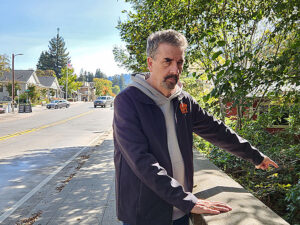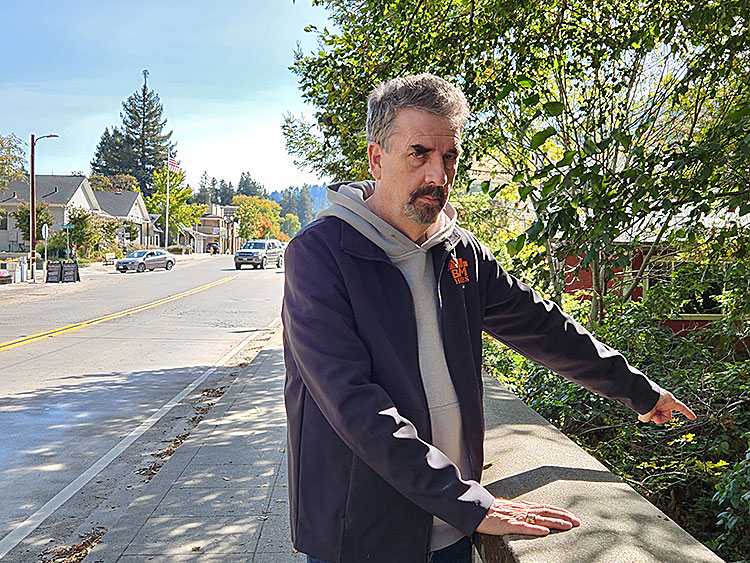By Tom Decker
Our San Lorenzo River watershed includes the communities of Bonny Doon, Boulder Creek, Brookdale, Ben Lomond, Felton, Lompico, Zayante, Mount Hermon and Scotts Valley. Our watershed has the highest septic system density of any comparable area in the state of California.
Within the 138 square miles of the watershed are more than 13,000 individual on-site private septic systems.
We live in Ben Lomond. We greatly appreciate and value the natural beauty of our forests, streams, creeks and the San Lorenzo River that flows through our valley.
We all want clean, pure drinking water. We all want our San Lorenzo River to be clean and safe for people, wildlife and fish.
The state of California tells us that they want the same things that we do. Nevertheless, the state’s answer for solving local problems often makes the problems worse.

Tom Decker points out to county Environmental Health workers where homeless are using the San Lorenzo River in Boulder Creek for a toilet.
A year ago, on Oct. 14, 2021, the Santa Cruz County Board of Supervisors voted to approve the Local Agency Management Program for our area. This is the state’s plan for oversight of septic systems in the unincorporated areas of Santa Cruz County.
The program is many pages long. What really stood out was the state’s concern over the large number of standard and non-standard private septic systems in the SLV watershed area.
The intention of the program is to protect our watershed, and keep our watershed safe for people, wildlife and fish. In order to achieve this, the LAMP program imposes some very harsh financial requirements on the homeowners in our area.
When fully implemented, the LAMP program would require a homeowner to replace their septic system with an engineered wastewater management system if it didn’t pass the state’s new certification standards.
These systems are very expensive. The current cost to install an engineered system ranges from $75,000 to over $140,000. These systems also require 24/7 monitoring, which costs an additional $250 to $300 every month. The state expects the homeowners in our area to accept this very expensive solution to achieve a questionable result without questioning why.
We all want clean drinking water. The SLV Water District gets most of its water from the many mountain springs in our watershed. The quality and purity of our water consistently ranks among the best in the state.
We would like to swim in the river. Longtime residents of SLV will fondly recall swimming in the public swimming pools in Ben Lomond and Lompico every summer. These communities used these public pools on the river for decades.
Then the state put an end to using the river for public swimming.
They told us the reason for this was so fish could swim unimpeded in the San Lorenzo River.
Historically, the San Lorenzo River had the largest population of steelhead trout and Coho salmon of any river in Central California.
Sixty years ago, the San Lorenzo River was home to one of the largest steelhead trout and Coho salmon hatcheries in the state. Then the state shut down the hatcheries. Since then, the trout and salmon population in the San Lorenzo River has dropped to almost zero.
A possible but never spoken-of solution to that problem might be to reopen the fish hatcheries.
It’s no wonder the residents of the SLV watershed area are upset. We don’t trust the state. We are angry about the harsh financial consequences being put on us from the LAMP program. We no longer trust the state as they try to impose their will in this very local matter.
The state wants the LAMP program to require every septic system in our watershed to be inspected and state-certified. They have a zero tolerance policy for failed systems.
What if every homeowner in the SLV watershed was ready, willing and able to replace their septic system with a new (and very expensive) engineered wastewater management system, how much would that help with the problem of wastewater getting into our watershed? No one really knows.
That’s a very important question.
A few weeks ago, we discovered a homeless man living in a heavily wooded corner of our property in downtown Boulder Creek. The San Lorenzo River flows along the southern border of our property. We discovered that this man, along with a number of other homeless individuals, had been using the river under the Highway 9 bridge in Boulder Creek as their toilet.
We called the County’s Environmental Health Department. They sent out a crew to clean up the mess.
Last week, I discovered again the river under the bridge was still being used by the homeless as their toilet. Based upon my very small and unscientific sample, I wonder how many times and in how many other locations along the 26 miles of the San Lorenzo River is this happening on a daily basis?
I’m curious if the state has factored in this information when determining the amount of raw sewage that is in our watershed.
The sad irony is that no matter how much we spend to upgrade our septic systems to meet the new state standards, it will never be enough. I believe that the minimal results achieved will never justify the high cost paid to achieve them.
The residents in the SLV watershed area are very diverse group. Nevertheless, there is one place where we all share common ground. Everyone has a septic system.
Any program that forces homeowners to spend more money to upgrade their septic system will not be received well.
To find out how the public feels about the LAMP, check out the public comment portion of the Oct. 18 Board of Supervisors meeting. On your computer search engine enter: Board of Supervisors Santa Cruz County, California. When you get to the BOS website, in the box on the left click on: Minutes and Agendas. Click on the Tuesday, Oct. 18, 9 a.m. meeting: Video.
The public comment part of this video starts at: 3:10. You will see and hear many of your friends, neighbors and community members addressing this issue at that public meeting.
After hearing from the many members of the public, all of them opposed to the LAMP, our supervisors wisely voted modify some of the conditions of the LAMP. Our supervisors also wisely decided to kick the can down the road and look at this matter again at some later time.
It appears that the residents of the SLV watershed won this fight. Nevertheless, the war to require homeowners in the SLV watershed to upgrade their septic systems is far from won.
Stay vigilant.

